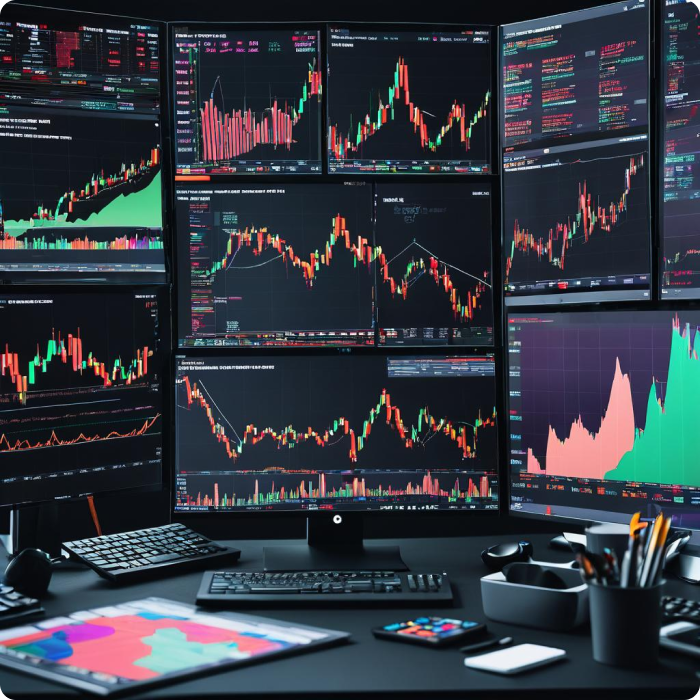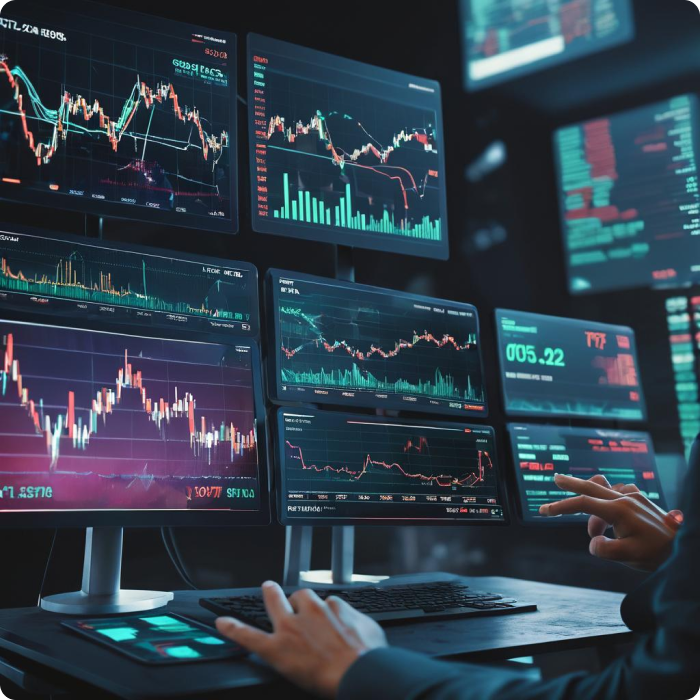Blog

Unlocking the Secrets of Algorithmic Trading: How to Navigate the Financial Markets Like a Pro
Algorithmic trading has revolutionized the way financial markets operate, offering traders the ability to execute trades with unprecedented speed and efficiency. By harnessing the power of advanced algorithms and computing technology, algorithmic traders can capitalize on market opportunities that may be invisible to the human eye. In this article, we will delve into the world of algorithmic trading, uncovering its secrets and providing insights on how to navigate the financial markets like a pro.
Introduction to Algorithmic Trading
Algorithmic trading, also known as algo-trading or automated trading, refers to the use of computer programs to execute trading strategies with minimal human intervention. These algorithms are designed to analyze market data, identify trading opportunities, and execute orders at lightning-fast speeds. The practice of algorithmic trading has gained widespread popularity in recent years, thanks to its ability to deliver consistent returns and outperform traditional trading methods.
Benefits of Algorithmic Trading
One of the primary benefits of algorithmic trading is its efficiency and speed. Unlike human traders who may take seconds or even minutes to execute a trade, algorithms can execute trades in a matter of milliseconds, allowing traders to capitalize on fleeting market opportunities. Additionally, algorithmic trading eliminates the risk of human error, ensuring that trades are executed according to predefined parameters without emotion or bias.
Key Components of Algorithmic Trading
Algorithmic trading involves several key components, including data collection and analysis, strategy formulation, execution of trades, and risk management. Successful algorithmic traders must have access to reliable market data and analytics tools, as well as a robust trading platform that can handle high-frequency trading.
Types of Algorithmic Trading Strategies
There are several types of algorithmic trading strategies, each designed to exploit different market conditions and inefficiencies. Trend-following strategies aim to capitalize on the momentum of a particular asset, while mean reversion strategies seek to profit from the tendency of prices to revert to their mean over time. Market-making strategies involve providing liquidity to the market by continuously quoting bid and ask prices, while arbitrage strategies exploit price discrepancies between different markets or assets.
Technical Requirements for Algorithmic Trading
To engage in algorithmic trading, traders need access to certain technical requirements, including a high-speed internet connection, a reliable trading platform, and access to market data and analytics tools. Additionally, algorithmic traders must have a deep understanding of programming languages such as Python or R, which are commonly used to develop trading algorithms.
Developing Your Algorithmic Trading Strategy
Developing a successful algorithmic trading strategy requires careful planning and analysis. Traders must define their objectives and risk tolerance, backtest their strategies using historical data, and optimize and refine their strategies based on the results. It is also essential to continuously monitor and adjust the strategy based on changing market conditions.
Risk Management in Algorithmic Trading
While algorithmic trading offers the potential for significant profits, it also carries inherent risks. To mitigate these risks, traders must implement robust risk management measures, such as setting stop-loss orders, diversifying their strategies and assets, and closely monitoring market conditions. By carefully managing risk, traders can protect their capital and minimize potential losses.
Regulatory Considerations
Algorithmic trading is subject to various regulatory considerations, including compliance with financial regulations and implications for market stability. Regulators closely monitor algorithmic trading activities to ensure fairness, transparency, and market integrity. Traders must adhere to regulatory requirements and stay informed about any changes or updates to ensure compliance.
Common Challenges and Pitfalls
Despite its potential benefits, algorithmic trading is not without its challenges and pitfalls. Common challenges include over-optimization of strategies, technology failures and disruptions, and market volatility. Traders must be prepared to navigate these challenges effectively and adapt their strategies accordingly to succeed in the competitive world of algorithmic trading.
Future Trends in Algorithmic Trading
The future of algorithmic trading is filled with exciting possibilities, thanks to advancements in artificial intelligence and machine learning. These technologies are enabling traders to develop more sophisticated algorithms capable of analyzing vast amounts of data and adapting to changing market conditions in real-time. Additionally, the integration of alternative data sources such as social media sentiment and satellite imagery is providing traders with new insights and opportunities.
Ethical Consideration
Ethical considerations are paramount in algorithmic trading, as the use of advanced technology and automation can raise concerns about fairness, transparency, and market manipulation. It is essential for algorithmic traders to adhere to ethical standards and conduct their activities with integrity.
Fairness and transparency are critical aspects of ethical algorithmic trading. Traders must ensure that their algorithms do not unfairly disadvantage other market participants or manipulate market prices. This includes avoiding practices such as front-running or spoofing, which can distort market conditions and harm investors.
Transparency is also crucial in algorithmic trading, as traders must be able to explain the rationale behind their trading decisions and provide clear documentation of their strategies and algorithms. This transparency helps build trust with investors and regulators and ensures that algorithmic trading activities are conducted in a responsible manner.
Addressing concerns about market manipulation is another important ethical consideration in algorithmic trading. Traders must be vigilant against activities that could artificially inflate or deflate market prices, such as pump-and-dump schemes or coordinated trading by large institutional investors. By adhering to ethical principles and regulatory guidelines, traders can help maintain the integrity and stability of financial markets.

Unlocking the Secrets of Algorithmic Trading: How to Navigate the Financial Markets Like a Pro
Algorithmic trading has revolutionized the way financial markets operate, offering traders the ability to execute trades with unprecedented speed and efficiency. By harnessing the power of advanced algorithms and computing technology, algorithmic traders can capitalize on market opportunities that may be invisible to the human eye. In this article, we will delve into the world of algorithmic trading, uncovering its secrets and providing insights on how to navigate the financial markets like a pro.
Introduction to Algorithmic Trading
Algorithmic trading, also known as algo-trading or automated trading, refers to the use of computer programs to execute trading strategies with minimal human intervention. These algorithms are designed to analyze market data, identify trading opportunities, and execute orders at lightning-fast speeds. The practice of algorithmic trading has gained widespread popularity in recent years, thanks to its ability to deliver consistent returns and outperform traditional trading methods.
Benefits of Algorithmic Trading
One of the primary benefits of algorithmic trading is its efficiency and speed. Unlike human traders who may take seconds or even minutes to execute a trade, algorithms can execute trades in a matter of milliseconds, allowing traders to capitalize on fleeting market opportunities. Additionally, algorithmic trading eliminates the risk of human error, ensuring that trades are executed according to predefined parameters without emotion or bias.
Key Components of Algorithmic Trading
Algorithmic trading involves several key components, including data collection and analysis, strategy formulation, execution of trades, and risk management. Successful algorithmic traders must have access to reliable market data and analytics tools, as well as a robust trading platform that can handle high-frequency trading.
Types of Algorithmic Trading Strategies
There are several types of algorithmic trading strategies, each designed to exploit different market conditions and inefficiencies. Trend-following strategies aim to capitalize on the momentum of a particular asset, while mean reversion strategies seek to profit from the tendency of prices to revert to their mean over time. Market-making strategies involve providing liquidity to the market by continuously quoting bid and ask prices, while arbitrage strategies exploit price discrepancies between different markets or assets.
Technical Requirements for Algorithmic Trading
To engage in algorithmic trading, traders need access to certain technical requirements, including a high-speed internet connection, a reliable trading platform, and access to market data and analytics tools. Additionally, algorithmic traders must have a deep understanding of programming languages such as Python or R, which are commonly used to develop trading algorithms.
Developing Your Algorithmic Trading Strategy
Developing a successful algorithmic trading strategy requires careful planning and analysis. Traders must define their objectives and risk tolerance, backtest their strategies using historical data, and optimize and refine their strategies based on the results. It is also essential to continuously monitor and adjust the strategy based on changing market conditions.
Risk Management in Algorithmic Trading
While algorithmic trading offers the potential for significant profits, it also carries inherent risks. To mitigate these risks, traders must implement robust risk management measures, such as setting stop-loss orders, diversifying their strategies and assets, and closely monitoring market conditions. By carefully managing risk, traders can protect their capital and minimize potential losses.
Regulatory Considerations
Algorithmic trading is subject to various regulatory considerations, including compliance with financial regulations and implications for market stability. Regulators closely monitor algorithmic trading activities to ensure fairness, transparency, and market integrity. Traders must adhere to regulatory requirements and stay informed about any changes or updates to ensure compliance.
Common Challenges and Pitfalls
Despite its potential benefits, algorithmic trading is not without its challenges and pitfalls. Common challenges include over-optimization of strategies, technology failures and disruptions, and market volatility. Traders must be prepared to navigate these challenges effectively and adapt their strategies accordingly to succeed in the competitive world of algorithmic trading.
Future Trends in Algorithmic Trading
The future of algorithmic trading is filled with exciting possibilities, thanks to advancements in artificial intelligence and machine learning. These technologies are enabling traders to develop more sophisticated algorithms capable of analyzing vast amounts of data and adapting to changing market conditions in real-time. Additionally, the integration of alternative data sources such as social media sentiment and satellite imagery is providing traders with new insights and opportunities.
Ethical Consideration
Ethical considerations are paramount in algorithmic trading, as the use of advanced technology and automation can raise concerns about fairness, transparency, and market manipulation. It is essential for algorithmic traders to adhere to ethical standards and conduct their activities with integrity.
Fairness and transparency are critical aspects of ethical algorithmic trading. Traders must ensure that their algorithms do not unfairly disadvantage other market participants or manipulate market prices. This includes avoiding practices such as front-running or spoofing, which can distort market conditions and harm investors.
Transparency is also crucial in algorithmic trading, as traders must be able to explain the rationale behind their trading decisions and provide clear documentation of their strategies and algorithms. This transparency helps build trust with investors and regulators and ensures that algorithmic trading activities are conducted in a responsible manner.
Addressing concerns about market manipulation is another important ethical consideration in algorithmic trading. Traders must be vigilant against activities that could artificially inflate or deflate market prices, such as pump-and-dump schemes or coordinated trading by large institutional investors. By adhering to ethical principles and regulatory guidelines, traders can help maintain the integrity and stability of financial markets.

Feature One

Feature Two

Feature Three

Feature One

Feature Two
